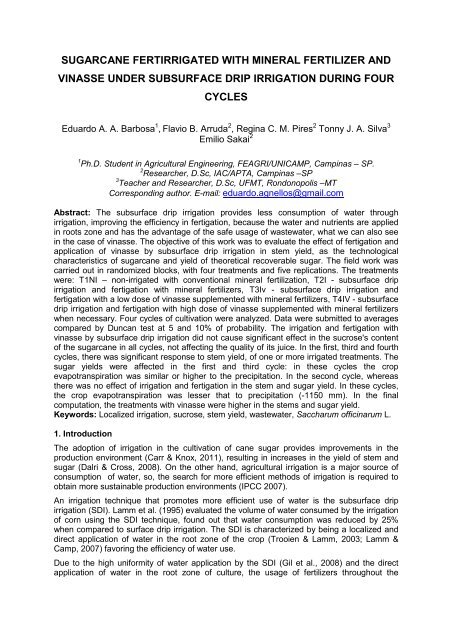poster - International Conference of Agricultural Engineering
poster - International Conference of Agricultural Engineering
poster - International Conference of Agricultural Engineering
You also want an ePaper? Increase the reach of your titles
YUMPU automatically turns print PDFs into web optimized ePapers that Google loves.
SUGARCANE FERTIRRIGATED WITH MINERAL FERTILIZER AND<br />
VINASSE UNDER SUBSURFACE DRIP IRRIGATION DURING FOUR<br />
CYCLES<br />
Eduardo A. A. Barbosa 1 , Flavio B. Arruda 2 , Regina C. M. Pires 2 Tonny J. A. Silva 3<br />
Emilio Sakai 2<br />
1 Ph.D. Student in <strong>Agricultural</strong> <strong>Engineering</strong>, FEAGRI/UNICAMP, Campinas – SP.<br />
2 Researcher, D.Sc, IAC/APTA, Campinas –SP<br />
3 Teacher and Researcher, D.Sc, UFMT, Rondonopolis –MT<br />
Corresponding author. E-mail: eduardo.agnellos@gmail.com<br />
Abstract: The subsurface drip irrigation provides less consumption <strong>of</strong> water through<br />
irrigation, improving the efficiency in fertigation, because the water and nutrients are applied<br />
in roots zone and has the advantage <strong>of</strong> the safe usage <strong>of</strong> wastewater, what we can also see<br />
in the case <strong>of</strong> vinasse. The objective <strong>of</strong> this work was to evaluate the effect <strong>of</strong> fertigation and<br />
application <strong>of</strong> vinasse by subsurface drip irrigation in stem yield, as the technological<br />
characteristics <strong>of</strong> sugarcane and yield <strong>of</strong> theoretical recoverable sugar. The field work was<br />
carried out in randomized blocks, with four treatments and five replications. The treatments<br />
were: T1NI – non-irrigated with conventional mineral fertilization, T2I - subsurface drip<br />
irrigation and fertigation with mineral fertilizers, T3Iv - subsurface drip irrigation and<br />
fertigation with a low dose <strong>of</strong> vinasse supplemented with mineral fertilizers, T4IV - subsurface<br />
drip irrigation and fertigation with high dose <strong>of</strong> vinasse supplemented with mineral fertilizers<br />
when necessary. Four cycles <strong>of</strong> cultivation were analyzed. Data were submitted to averages<br />
compared by Duncan test at 5 and 10% <strong>of</strong> probability. The irrigation and fertigation with<br />
vinasse by subsurface drip irrigation did not cause significant effect in the sucrose's content<br />
<strong>of</strong> the sugarcane in all cycles, not affecting the quality <strong>of</strong> its juice. In the first, third and fourth<br />
cycles, there was significant response to stem yield, <strong>of</strong> one or more irrigated treatments. The<br />
sugar yields were affected in the first and third cycle: in these cycles the crop<br />
evapotranspiration was similar or higher to the precipitation. In the second cycle, whereas<br />
there was no effect <strong>of</strong> irrigation and fertigation in the stem and sugar yield. In these cycles,<br />
the crop evapotranspiration was lesser that to precipitation (-1150 mm). In the final<br />
computation, the treatments with vinasse were higher in the stems and sugar yield.<br />
Keywords: Localized irrigation, sucrose, stem yield, wastewater, Saccharum <strong>of</strong>ficinarum L.<br />
1. Introduction<br />
The adoption <strong>of</strong> irrigation in the cultivation <strong>of</strong> cane sugar provides improvements in the<br />
production environment (Carr & Knox, 2011), resulting in increases in the yield <strong>of</strong> stem and<br />
sugar (Dalri & Cross, 2008). On the other hand, agricultural irrigation is a major source <strong>of</strong><br />
consumption <strong>of</strong> water, so, the search for more efficient methods <strong>of</strong> irrigation is required to<br />
obtain more sustainable production environments (IPCC 2007).<br />
An irrigation technique that promotes more efficient use <strong>of</strong> water is the subsurface drip<br />
irrigation (SDI). Lamm et al. (1995) evaluated the volume <strong>of</strong> water consumed by the irrigation<br />
<strong>of</strong> corn using the SDI technique, found out that water consumption was reduced by 25%<br />
when compared to surface drip irrigation. The SDI is characterized by being a localized and<br />
direct application <strong>of</strong> water in the root zone <strong>of</strong> the crop (Trooien & Lamm, 2003; Lamm &<br />
Camp, 2007) favoring the efficiency <strong>of</strong> water use.<br />
Due to the high uniformity <strong>of</strong> water application by the SDI (Gil et al., 2008) and the direct<br />
application <strong>of</strong> water in the root zone <strong>of</strong> culture, the usage <strong>of</strong> fertilizers throughout the

















